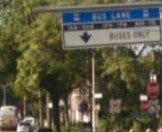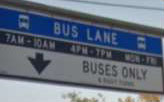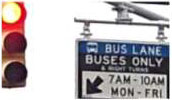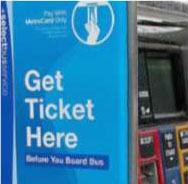The Justice System Case for Radical Incrementalism
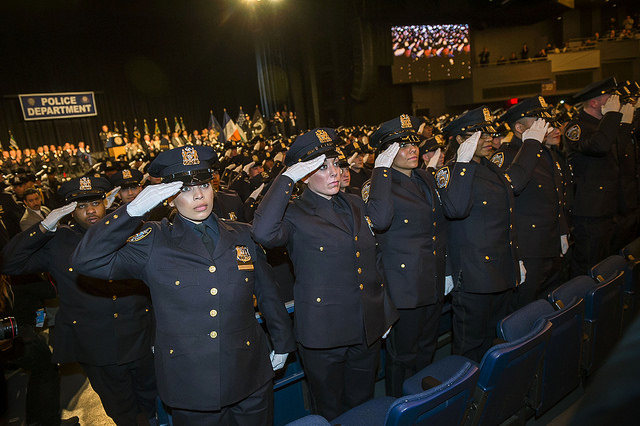
(photo: Ed Reed/Mayoral Photography Office)
Social media was full of despair as advocates bemoaned the failure of New York state government to approve bail reform legislation in the recently-passed budget. The push to eliminate cash bail brought together dozens of organizations and hundreds of concerned citizens to advance an important reform. This kind of mobilization is not atypical – advocacy campaigns tend to focus on passing legislation or electing officials.
Eliminating cash bail is a good idea, and over time, our bet is that it will end up succeeding in Albany. But we know from the Independent Commission on New York City Criminal Justice and Incarceration Reform chaired by former Chief Judge Jonathan Lippman that you don’t need to pass new legislation in order to transform the justice system. Indeed, the commission made the case that it is possible to reimagine criminal justice in New York City – including closing Rikers Island – without any new legislation whatsoever. In fact, this process is already underway.
The Mayor’s Office of Criminal Justice has just announced that the city's jail population is now less than 8,500 – down from a high of over 20,000 in the 1990s. This did not happen overnight. It also did not happen thanks to the passage of any single piece of legislation or the election of any single official.
Reducing incarceration in New York City took place over the course of multiple decades and mayoral administrations. It was a slow, incremental process, involving dozens, if not hundreds of decisions by different agencies and actors, the vast majority of which never made newspaper headlines. For example, in 1997, New York City’s criminal court judges released roughly 50 percent of defendants on their own recognizance pending trial, without setting bail. Today, this figure is closer to 70 percent. The implications of this shift in practice are enormous – it adds up to tens of thousands of defendants being given the chance to avoid the harms and abuses of Rikers Island.
Based on our work in New York and our recent examination of successful reform efforts across the country in Start Here, we argue for an approach to criminal justice reform that focuses on practice not politics. We believe that we need to transform the culture of our justice system – and that the best way to achieve this is by working directly with the police officers, prosecutors, judges, and correctional officials who staff our precincts, jails, and courts to help them change the way they do their jobs on a daily basis.
Many criminal justice reformers go over the heads of practitioners and speak directly to elected officials. Legislating change is an enormously tempting path to pursue. A successful bill in Albany or Washington can alter the course of government more or less overnight. At least that's the promise. In reality, things often don't pan out that way.
As Michael Lipsky pointed out more than a generation ago in Street-Level Bureaucracy, frontline staffers can sabotage or undermine any initiative that they do not believe in. That's why real criminal justice reform requires time – time to change the hearts and minds of the people who run the criminal justice system.
Let’s be real: it can be profoundly frustrating to take an incrementalist approach to reform. While there is much to celebrate in New York City, which now has the lowest rate of incarceration of any major American city to go along with dramatically reduced levels of crime, there is also much work still to be done. A trip to criminal court reveals that racial disparities are still very much with us. A visit to Rikers Island indicates that we have a long way to go before we can say that our system treats defendants with decency and dignity.
Here are three changes in practice that would go a long way toward making our justice system more fair and more effective.
First, police officers and prosecutors need to create off-ramps so that more low-level cases can be diverted out of the system entirely. Second, judges and court administrators need to do everything in their power to expedite case processing and avoid unnecessary delays – especially when defendants are being held in jail pretrial. And finally, elected officials need to make deeper investments in pretrial services and alternative sentencing programs so that judges have options beyond jail and nothing.
None of these fixes requires new laws to be passed -- just the active engagement of the people who run the justice system in New York City. The good news is that policymakers are aggressively pursuing all of the above.
New York City is a case study for the kind of justice reform that takes a long time to see to fruition – but it’s the kind of reform that is both durable and sustainable. The process is gradual; the results are nothing short of radical.
***
Greg Berman is the director of the Center for Court Innovation and co-author of Start Here: A Road Map to Reducing Incarceration (The New Press). Julian Adler is the director of policy and research at the Center for Court Innovation and co-author of Start Here.
***
Have an op-ed idea or submission for Gotham Gazette? Email This email address is being protected from spambots. You need JavaScript enabled to view it.
A Closer Look at This Year’s Specialized High School Admissions
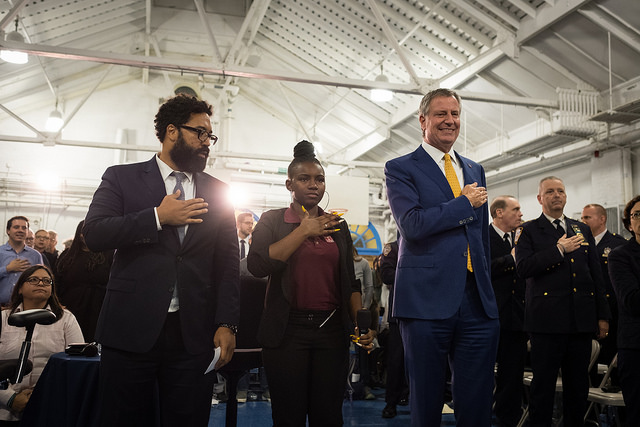
(Edwin J. Torres/Mayoral Photography Office)
Critics of the test used for admitting students to New York City’s specialized high schools -- Brooklyn Tech, Stuyvesant, Bronx Science, and five others -- failed to properly assess this year’s test and admission results because they yearned for a more robust increase in offers to black and Latino students, when compared to the year before. The city had improved the test and increased outreach and free test prep, all efforts intended to redress their underrepresentation, but in a school system where more than 70 percent of students are from black and Latino families, just 10 percent of the seats in the specialized high schools were offered to students from those communities.
This disparity is unacceptable. But so too is a failure to properly analyze the test and admission results, and thereby call the city’s efforts a total failure and demand simply that the test be eliminated in one way or the other. Such an approach overlooks what is and can be done to help remedy the city’s decades of neglect in many of the schools serving black and Latino communities.
While a sudden turnaround was not to be expected, this year’s test results did show that as a percentage of all offers, there was a small increase in offers made to black students. In absolute terms, 207 black students received offers compared to 194 the year before. On the other hand, Latino admissions declined by 10, to 320 from the latest test. Because both white and Asian offers of enrollment declined this year, both absolutely and as a percentage of total offers made, it could be argued that these results potentially show an inflection point for black admissions. However, since the students self-identifying as “multi-racial” nearly doubled, to 128, and because the race of 419 others is unknown, it would be premature to make such a claim.
Also ignored by critics of the test, was any appreciation of the city’s contradictory efforts.
On the one hand, it increased free test prep. On the other, it changed the test, making it harder to prepare. While the Brooklyn Tech Alumni Foundation, which I head, supported changing the test to make it better aligned with what is supposed to be taught in our schools, and thereby mitigate against a test prep advantage, we shouldn’t entirely ignore this issue in our discussion of the latest test’s results.
Notably, while 450 more Asian students took the test this year, fewer were admitted this year than last in both absolute and percentage terms. Because the accusation has frequently been made that the test’s results are skewed because so many Asian students do test prep, the city’s effort to mitigate test prep advantages may well have worked. Since the city is again changing the test to be administered later this year, by, for example, including poetry, a fair and proper assessment of the city’s efforts may take a few more years.
Other efforts can and should be made. One step the city could take is to revamp the Discovery Program – a long-standing, if unused, program which lets “disadvantaged” students who fall just short of the test’s cut-off score get a second chance for admission. By a targeted redefinition of what “disadvantaged” means, focusing on the underrepresented schools and communities, more high-performing black and Latino students will have increased chances for success.
Another effort that should be adopted is the bill in Albany sponsored by Bronx State Senator Jamaal Bailey, a Bronx Science graduate, that mandates administration of a free and voluntary practice SHSAT, the specialized high school test, to be offered in sixth grade, with students receiving an analysis of test results to identify areas in need of improvement before the test is given in eighth grade. We give a PSAT for obvious reasons, why not a PSHSAT?
Alumni from all eight test-in schools believe deeply in increasing diversity at their schools, but believe just as deeply in keeping the test as the single criterion for admissions as an objective measure immune to the kinds of influence many more affluent white families use to gain entry for their children to better schools that use the kind of subjective criteria that Mayor de Blasio and others have said should replace the test. For example, the student body of Brooklyn Tech, which sits in the middle of Brownstone Brooklyn, is 80 percent students of color.
The decades of declining enrollment in specialized high schools experienced by the black and Latino communities correlates with the elimination of enriched educational programs at many of the elementary and middle schools in these communities. Today only 15 middle schools account for over half of the students in the specialized high schools; none are in black or Latino communities. A fair assessment of the city’s efforts simply cannot ignore the impact of decades of neglect by the Board of Education and its successor, the Department of Education.
Ultimately, the city needs a plan to promote the creation of pipeline middle schools located within the black and Latino communities of our city. This requires the creation of vibrant gifted and talented programs in the elementary schools and enriched coursework in the middle schools. The new chancellor would be well-advised to create such a plan.
At the same time, efforts to increase outreach, free test prep, reconfiguring the Discovery Program to enroll more disadvantaged students from black and Latino communities, among other measures, can help to promote more diversity at Brooklyn Tech and the other test-in high schools. Such efforts should be fairly and accurately evaluated, not skipped over in a rush to demand elimination of the test.
***
Larry Cary is a Manhattan lawyer and president of the Brooklyn Tech Alumni Foundation.
***
Have an op-ed idea or submission for Gotham Gazette? Email This email address is being protected from spambots. You need JavaScript enabled to view it.
The Great Select Bus Service Conspiracy: Part II
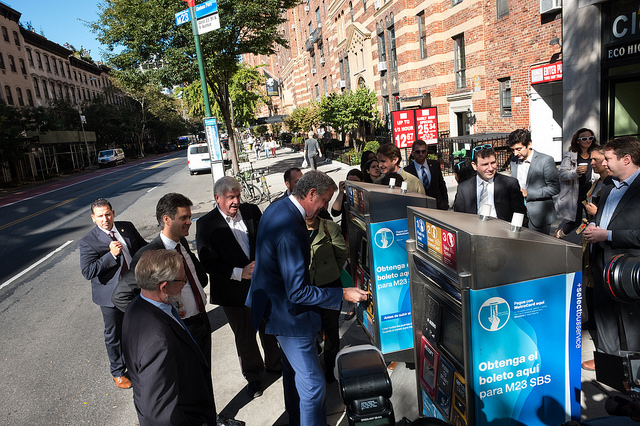
(photo: Edwin J. Torres/Mayor's Office)
This is part two of a three-part series
Denigration of Local Bus Service
In many cases, the introduction of SBS has resulted in a denigration of local bus service -- though this does not apply to Manhattan crosstown routes. Most notably this has occurred on the M15 First and Second Avenue routes in Manhattan and on the B44 and B46 routes in Brooklyn. Many riders who prefer the local are now forced to walk further to an SBS stop after waiting a half-hour for a local and seeing three SBS buses bypass their stop.
After implementation of the B44 SBS, complaints of long waits up to 45-minutes for the local forced the MTA to add additional local service, after three months and a new SBS stop at Avenue L. Although the B44 SBS uses the longer buses with a 50 percent greater capacity while the local uses standard length buses, local buses are more crowded since ridership is equally split between SBS and local. Riders complain of near empty SBS buses passing them by.
Problems with Enforcement
Passengers and cars are sometimes summonsed unfairly and a kangaroo court system exists where innocent people often are found guilty. Just a few examples: convicted for theft of services, a fine of $150, when it is proven at the hearing that there was a valid transfer on the MetroCard; cameras ticketing cars for crossing the bus lane when pulling out of or entering legal parking spaces; being summonsed during hours that a bus lane is not in effect, or a minute after it goes into effect or one minute before it is no longer in effect. Should someone be penalized with a fine exceeding $100 because his watch is a minute early or late? There should be a grace period of five minutes, as with muni-parking meters. And summonses mailed three months later make it difficult to mount a court defense.
There was at least one instance in 2014, captured on video, of police shoving, harassing and kicking a passenger for five minutes after getting off the bus, although he produces ID and an SBS receipt as requested. We do not know what interactions preceded the video but it appears from the video that the individual is doing nothing wrong.
There have been instances where bus operators have told passengers to board the bus because all fare machines at a bus stop were broken and to get off at the next stop to obtain a receipt. However, before they could comply, the Eagle Team boarded the bus and summonsed them. This would not leave a favorable opinion about New York City if it happened to a tourist. The MTA has since clarified its fare payment policy when all machines at a bus stop are inoperable.
|
|
|
|
|
|
|
|
|
|
|
|
Other SBS Problems
Fare machines on the first route (Bx12) had to be replaced after three years because no one thought of providing weather protection, wasting millions. There are many SBS problems that the city and MTA have not resolved. These are: worn out pavement markings; poor and confusing signage for motorists; broken countdown time clocks and fare machines sometimes not repaired for months; inadequate exclusive bus lane enforcement; and riders who need an additional bus transfer due to SBS and are therefore required to pay extra fares to utilize SBS. (The governor recently vetoed legislation permitting an extra bus transfer for a single fare.)
The picture of the Nostrand Avenue bus lane in Sheepshead Bay was taken a year after implementation in 2014. It still has not been repainted.
Drivers are supposed to know that right turns must be made from the bus lane even on blocks where a “Buses Only” sign is posted on the prior block, although there is no additional signage to indicate that. Actually, right turns must be made from the bus lane about 50 feet after the “Buses Only” sign (pictured). Where signs do indicate right turns
are allowed (pictured) the words “& Right Turns” are too small to be easily read at speeds over 20 MPH. They should be the same size as the words “Buses Only.”
Machines are not always placed where they are easily seen, making them easy to miss if you are running for a bus and are not aware beforehand that the route is SBS. Occasionally, non-SBS wrapped buses are used in SBS service which accept fares subjecting you to a summons if you board not realizing you are on an SBS bus. The signage at bus stops also could be clearer. The print stating "Get Ticket Here" and in much smaller print "Before You Board Bus" could be interpreted as paying before you board is an option. “Get Ticket Here” should be preceded with "YOU MUST" in large capital letters. To make matters worse, bus operators may not inform confused passengers who they see boarding without a receipt that one is necessary.
The 60-foot buses used on many SBS routes are more difficult to maneuver, do not work well in snow storms, have higher labor and fuel costs, and are more inefficient than 40-footers when the bus is lightly loaded. Yet the MTA does not substitute them with regular-length buses during times of light usage, such as during evening and overnight hours.
All SBS problems need to be addressed before the system is expanded further.
Negative Effects on Traffic and Local Businesses
There have also been negative effects on traffic caused by exclusive bus lanes that are being ignored or explained away. The Woodhaven Boulevard SBS has helped increase automobile travel times during peak hours by as much as 45 minutes. This is significant because about 80 percent of motor vehicle traffic is not bus riders and SBS is not attractive enough for people to switch to the bus. Bus lanes on Woodhaven Boulevard do not result in faster buses in the off-peak, but are mostly in effect 24/7 anyway. Curbside bus lanes on Saturdays were not necessary and have hurt businesses. The longer bus stops required for 60-foot buses reduce available parking.
DOT is proposing exclusive bus lanes on the wide portion of Kings Highway for the B82 where buses are already traveling near the 25 MPH speed limit except for three hours a day. This will also negatively affect traffic and will not benefit bus passengers. Merchants and elected officials are opposing bus lanes on the narrow portion of the road.
Public Participation is Inadequate
The “democratic process” used to create SBS routes is an illusion. There is no specific outreach to alert motorists; public meetings are not adequately publicized, and there have been complaints of some of them being held at inconvenient hours; SBS information for proposed routes and SBS progress reports are difficult to find on the internet; no public hearings (different from meetings) are held; many community concerns and negatives, such as reduced parking, are ignored; half-truths are presented with many omissions; DOT and the MTA only respond to questions they want to answer.
Community groups are allowed only one representative at Community Advisory Committee meetings. However, DOT stacked at least one of the 2015 Woodhaven Boulevard meetings with three supporters from Transportation Alternatives.
When actual traffic data was questioned, it was substituted with modeling data not presented at that meeting. The presentation was then revised and backdated to make it appear the modeling data was presented at the meeting rather than the actual traffic data. Modeling assumptions were not revealed.
After initially stating to the communities that there was no relation between SBS and Vision Zero, DOT made SBS and Vision Zero part of the Complete Streets Program in order to use funding earmarked for Vision Zero to expand SBS. Underhanded tactics such as these have been a hallmark of the SBS program.
The process is dragged out to give the illusion of democracy when many meetings are not even necessary. Combined meetings could be held with more than one merchants’ association at a time in a given corridor cutting years off the SBS implementation process.
Instead, the divide and conquer strategy is used to prevent many negative opinions at the same time. It also affords the agencies the opportunity to provide different and conflicting responses to each group. The same strategy was used at the presentations to the general public. Plans are presented in bits and pieces so that communities do not see the complete plan. The promises and positives of SBS were presented as a sales pitch. The public was then divided into workshops of six people each with the discussions led by DOT employees, ensuring that everyone heard all the positives but not the negatives in coherent form. That resulted in no negative being heard by more than five other individuals instead of 30.
At the initial meetings, at least along Woodhaven Boulevard, problems and suggestions from communities were discussed with SBS presented as one possible solution. At subsequent meetings SBS was proposed as the only solution for all bus problems and community support was requested. At one Woodhaven Residents Block Association meeting where DOT was summoned to attend, an informal vote of SBS support was taken in which 100 opposed the SBS plan and only one was in favor. DOT’s response was that SBS would still be implemented. Since SBS was now a given, curbside bus lanes were proposed by the community, but DOT chose center roadway lanes instead, over community fears of decreased safety.
Any suggestion other than SBS is summarily dismissed. Only massive and organized protests can alter the pre-existing SBS solution. It took a major effort to reverse most of DOT’s 26 additional proposed left turn restrictions on Woodhaven Boulevard; DOT admitted to only 19 on the last page of their FAQ document, implementing a northbound restriction at Rockaway Blvd, while proposing a southbound restriction. Still, there are no signs to alert drivers where the next left turn is allowed, while they are only about once a mile, despite DOT promises of advance signage. That causes unfamiliar drivers to go far out of their way since right turns are also not allowed from the center roadway except for a few slip lanes.
Just recently, DOT agreed to eliminate Saturday bus lanes on Cross Bay Boulevard. Repeated suggestions for a B44 SBS stop at Avenue R were ignored prior to implementation. Residents and elected officials have now been fighting for five years for this needed bus stop.
Community involvement is far from adequate.
This is part two of a three-part series. Read part one here. The final part discusses why SBS is not a cure all, if it can work, and whether it is worth it.
***
Allan Rosen is a former director of Bus Planning for MTA New York City Transit. On Twitter @BrooklynBus.
***
Have an op-ed idea or submission for Gotham Gazette? Email This email address is being protected from spambots. You need JavaScript enabled to view it.
Assignment for the New Schools Chancellor: Address Race Head-On
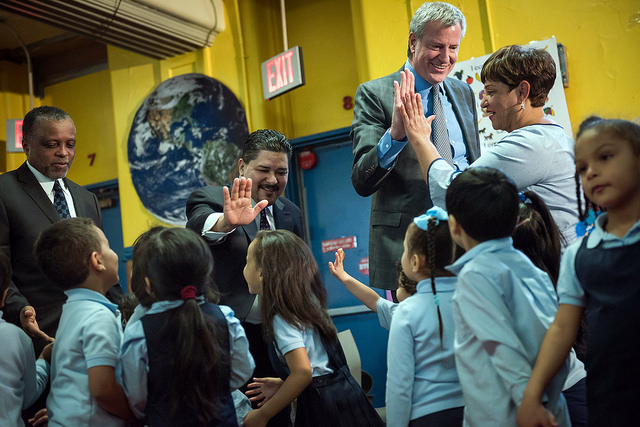
(Credit: Photographer/Mayoral Photography Office)
When I was in 5th grade at a public elementary school in Manhattan, my teacher was Mrs. Camiji, and I loved her. She taught us about diverse cultures all over the world, and pushed us to think about what roles we could serve in our community. It was empowering to see her in front of the classroom. She was the first African-American classroom teacher I ever had, and the last African-American classroom teacher I had until college.
Ms. Camiji was part of the reason I have been so committed to education as an adult. Over the past four years, I dedicated hundreds of hours serving on the city’s Panel for Educational Policy and voting on hundreds of policies affecting the students of color who make up the vast majority of the city’s public school students. But extremely few of those policies have directly addressed the racism and bias in our schools that are obstacles to academic achievement.
In his State of the City speech a few months ago, Mayor de Blasio said, “We face an achievement gap today that is rooted in the enslavement of Americans and the pervasive discrimination against people of color over centuries. We know exactly where the problem comes from, but to defeat structural racism and to overcome this achievement gap, we have to flip the script. We have to do something different when it comes to education….”
The mayor is right, and he is in a position to change this. Former schools Chancellor Carmen Farina made many positive changes in New York City public schools - elevating the role of educators, diminishing the role of standardized tests, expanding community schools, and other great initiatives. But over the past four years, this administration has danced around issues of systemic racism in schools, unwilling to confront it directly.
Despite a deep body of research showing that students are more likely to succeed academically when they see themselves reflected in the books and curriculum they read, in the courses they take, in the issues discussed in class, I have seen very few system-wide policies that reflect this approach to advancing the success of students of color, beyond small and excellent initiatives like NYCMenTeach and Expanded Success Initiative.
I hope that the new leader of the school system, Chancellor Richard Carranza, will take up this issue and do more than the administration has so far.
Chancellor Carranza has seen first-hand, as a principal and a superintendent, the incredible impact on students of color when they learn about their own history and culture, and from educators who understand and connect with their history and culture. He has a reputation for engaging families in genuine and culturally appropriate ways, and knows the investment in schools that approach builds.
My daughter graduated from high school last year, and she never had an African-American classroom teacher in New York City public schools. In elementary school there was one African-American music teacher; in high school there was an African-American substitute science teacher. The students loved that science teacher, and my daughter confided in him and relied on his input to shape her decisions and keep her focused. But it’s a disgrace that my daughter’s teachers were no more diverse than my own, 25 years earlier.
Mayor de Blasio and Chancellor Carranza, let’s make this the last generation of New York City public school students who have to experience what my daughter and I have. Let’s grow the number of teachers and administrators of color, increase cultural competency among all teachers, and diversify curriculum and course offerings. This is the path to expanding academic success among our students of color, and for all students.
***
Elzora Cleveland is a former mayoral appointee on the Panel for Educational Policy, and a parent leader with the NYC Coalition for Educational Justice. On Twitter @CEJNYC.
***
Have an op-ed idea or submission for Gotham Gazette? Email This email address is being protected from spambots. You need JavaScript enabled to view it.
Promoting Tenant Advisory Groups in Supportive Housing
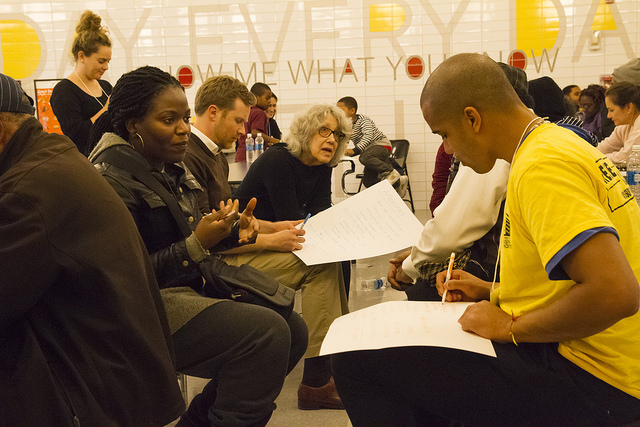
(photo via nycha/flickr)
The supportive housing model recognizes the inherent dignity in all people. Low-income tenants and people with mental health conditions who were formerly homeless are offered an affordable apartment combined with voluntary supports and services that can help increase self-determination. As supportive housing grows in New York and the country, tenant engagement and empowerment are recognized as important factors in maintaining secure and thriving residences.
Tenant advisory groups are a promising initiative taking hold in New York supportive housing, and may be a scalable approach to encouraging self-advocacy and recovery. In advisory groups, tenants exchange experiences, propose solutions and initiatives, and provide feedback to management regarding issues at their residences. This setting encourages tenants to advocate for their needs and collaborate on meaningful decisions about their home life and community.
Creating an advisory relationship between tenants and staff also builds trust and mutuality, which can be an important foundation for people as they recover from disempowerment experienced while homeless. In addition, it strengthens tenants’ communication and leadership skills as well as their relationships with neighbors and community members.
A tenant advisory group doesn’t only helps supportive housing tenants; the approach also enhances the residence itself. In particular, the process helps ensure issues at the residence are addressed by staff and senior leadership in a way that respects tenant priorities and preferences. Advisory group members become trusted peers in each residence, and can represent the needs of neighbors who don’t feel motivated to self-advocate. Elected tenant leaders also provide a valuable and personal perspective to staff that they may not access otherwise.
Community Access, a 44-year old nonprofit that empowers mental health recipients by providing quality housing and employment services, created a tenant advisory council, known as the Program Participant Advisory Group (PPAG), over four years ago. One of the first in New York City, the PPAG is a tenant body democratically elected by Community Access tenants that advises senior management and creates initiatives. For example, the PPAG designed a program that offers small grants to tenant applicants trying to regain employment. Grants have enabled tenants to complete courses in massage therapy and medical billing and obtain licenses and certificates in commercial driving and food handling. The PPAG also initiated karaoke events.
Each month, the PPAG brings its own karaoke equipment to a different Community Access residence and facilitates an event where tenants and staff share songs and build community as well as share events and community resources. Tenants travel from all over the city, getting to know new neighborhoods and meeting other tenants. Karaoke events are one of the most well-attended Community Access events, in part because they were started and are run by tenants.
Urban Pathways - a 43-year old social services and supportive housing nonprofit for homeless adults - also engages in robust advisory group efforts. Each transitional and permanent housing residence holds a regularly occurring self-advocacy group where individuals address residence issues and work on self-advocacy. Urban Pathways also holds a twice monthly Thursday night issue-based advocacy group for current and former clients to become better issue-based advocates. Recent speakers include the Deputy Chief of Staff to City Council Speaker Corey Johnson as well as the Chief of Staff and Deputy Chief of Staff to State Assembly Member Andrew Hevesi on the role of the city and state governments in advocacy.
In this framework of engaging and empowering supportive housing tenants, on Tuesday, April 17, from 3 to 5 p.m. there will be a Forum on Tenant Advisory Groups at Fountain House at 425 West 47th Street in Manhattan.
The forum - the first in a series - will focus on starting a group and empowering tenant advocacy. Supportive housing providers currently doing advisory groups - Community Access, Urban Pathways and Breaking Ground - will discuss barriers to creating groups, provide examples of best practices, and suggest resources for providers interested in establishing groups. There will also be an audience question-and-answer session focused on four areas: how advisory groups advocate for fellow tenants; getting staff on board; involving senior management; and future goals.
We encourage supportive housing tenants, staff, and management as well as recipients of mental health services to attend the Tuesday forum to learn about how advisory groups can build upon the strong legacy of supportive housing in New York and beyond.
***
Nicole Bramstedt is the Director of Policy at Urban Pathways, a nonprofit social services and supportive housing organization serving homeless adults. On Twitter at @UrbanPathwaysNY.
Carla Rabinowitz is the Advocacy Coordinator at Community Access, a 44-year old nonprofit that empowers mental health recipients by providing quality supportive housing and employment training. On Twitter at @ca_nyc.
***
Have an op-ed idea or submission for Gotham Gazette? Email This email address is being protected from spambots. You need JavaScript enabled to view it.
Andrew Cuomo’s Missing Endorsements
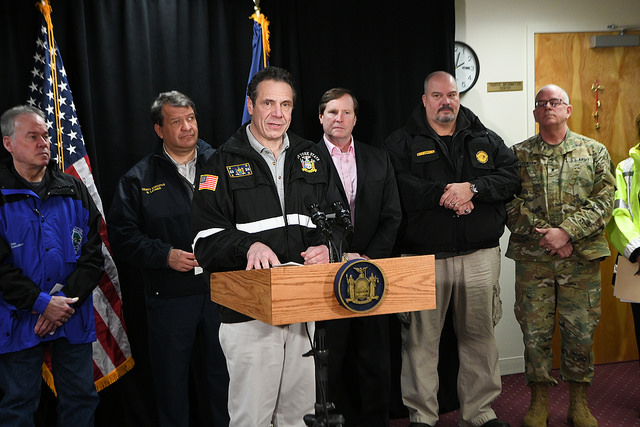
Gov. Cuomo (photo: Governor's Office)
On March 19, New York’s gubernatorial race intensified when actor and activist Cynthia Nixon declared her candidacy. The incumbent, Governor Andrew Cuomo, shifted into high gear, chasing down endorsements from all quarters. He got a few -- a Senator, some labor unions, an old rock star who doesn’t live in New York. All fine and good, but where are the endorsements from the New York City Council, the Public Advocate, City Comptroller and borough presidents? Even more curious, where are the endorsements from the 133 people who know him best?
Who are these 133 people? They are the Democratic members of the New York State Assembly and Senate. They are the elected representatives who ostensibly share an agenda with the governor and, in theory, work with him to pass laws. But all 133 Democratic members of the Senate and Assembly have remained conspicuously silent when it comes to the leader of their party. What’s more, they haven’t criticized Nixon’s primary challenge. Instead, they remain in patient equipoise at a time that Cuomo seems increasingly anxious to secure support against a formidable primary opponent. Why?
The Legislature is tired of Cuomo’s business as usual. First, lawmakers are no doubt angered by Cuomo’s repeated exclusion of the chosen leader of the Senate Democrats, Senator Andrea Stewart-Cousins, from budget negotiations and policy pushes. Never has this been more glaring than this year, when he publicly promised to seek her feedback on sexual harassment laws, and then reneged -- but kept Senator Jeffrey Klein in these negotiations despite the accusations of sexual assault recently leveled against him. In a year where the #MeToo movement has flexed its considerable political power, Cuomo underestimated the impact of excluding women from negotiations (resulting in a sexual harassment package, and budget, that is not even close to as strong as it could have been).
Second, Cuomo has mismanaged his preferred mechanism for excluding Senator Stewart-Cousins from the leadership, otherwise known the Independent Democratic Conference (IDC). Albany’s worst-kept secret is that this rogue group of senators, Democrats who have empowered Senate Republicans to run the State Senate since 2011, has been supported by Cuomo. Seven years ago, Cuomo could get away with this. Now, in the age of Trump, enabling Republicans is untenable.
It took Cuomo too long to realize his support of the IDC hurts him at the polls, as it has with fellow Democratic elected officials. In fact, in a miscalculation of epic proportions, he kept the IDC on during budget negotiations. He could have had a trifecta of Democrats (himself, Carl Heastie and Sen. Stewart-Cousins) build the budget, achieved if he had called special elections earlier in the year. Instead, he waited, calling them for April 24 so he could keep Sens. Jeff Klein and John Flanagan in budget negotiations with him instead. As a result, the budget left out major planks of the Democrats’ progressive platform, like early voting, the Child Victims Act, criminal justice reforms, and more. New Yorkers noticed. In particular, many Westchester voters (those suburban voters that Cuomo so eagerly courts) noticed because they went unrepresented in budget negotiations, and their empty Senate seat could have tipped the balance of the upper chamber to the Democrats.
This budget fiasco caused Cuomo to scramble to solve his IDC problem. His promised “deal” to reunify the IDC with the mainline Democrats, originally scheduled for after the special elections, abruptly accelerated. In a hastily devised agreement, Cuomo forced Sens. Stewart-Cousins and Klein to shake hands for the cameras and work out most of the details later, without even the courtesy of a heads-up to Sen. Stewart-Cousins before the meeting where he exerted a unifying power he had not-that-long-ago said he did not possess.
Democratic lawmakers across New York have good reason to doubt the veracity of this rushed reunification. (Progressives are also dubious.) Perhaps they recall 2014, when Cuomo, in order to secure the endorsement of the Working Families Party, promised to undo the IDC (that never happened). They see that the IDC continues to hold high-dollar fundraisers, with Cuomo in attendance, signalling that real unification has not happened at all, and the IDC’s return to the GOP is inevitable. Perhaps they are just tired of Democrats who need to be forced to work with their own party, who hold bills hostage in committee, and suck up an unfair share of legislative resources year after year. Whatever the reason, Cuomo’s after-the-fact “reunification” of the IDC with the mainline Democrats is truly a case of too little, too late.
The governor wants to get these missing 133 endorsements, by hook or by crook. During the press conference announcing the “reunification” deal, Cuomo declared by fiat that the newly united Democrats will support one another, including his gubernatorial campaign. Yet, the 133 endorsements have still failed to materialize. Democratic lawmakers are resisting Cuomo’s machinations in the one way they can, and as they say, the silence is deafening.
***
Lisa DellAquila is a co-leader of True Blue NY. Heather Stewart is an organizer with Empire State Indivisible. On Twitter @makeNYTrueBlue and @es_indivisible.
***
Have an op-ed idea or submission for Gotham Gazette? Email This email address is being protected from spambots. You need JavaScript enabled to view it.
The Great Select Bus Service Conspiracy: Part I
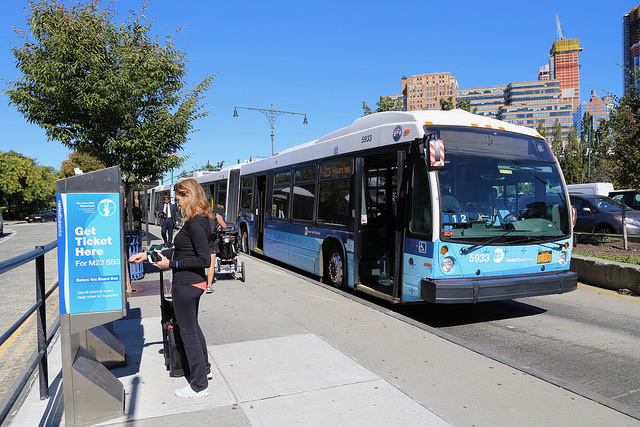
(photo via DOT)
This is part one of a three-part series
Select Bus Service (SBS), New York City's version of Bus Rapid Transit (BRT), has been embraced by the media as well as by many organizations. This is in addition to the city Department of Transportation (DOT) and the Metropolitan Transportation Authority (MTA) -- SBS is a joint project of the two agencies with DOT being the lead agency. Supporters include: Bus Turnaround Coalition, Move NY, NYPIRG Straphangers Campaign, Pratt Center for Community Development, New York Metropolitan Transportation Council, Riders Alliance, Rockefeller Foundation, Streetsblog, Transit Center, Transportation Alternatives, Tristate Transportation Campaign, Mayor de Blasio, Governor Cuomo, and the entire New York City Council.
Could they all possibly be wrong? Yes.
The Promises and The Reality
Supporters consider SBS to be a panacea for many of New York City’s bus problems. Whenever asked how the city is improving bus service, the response most often is that more SBS routes are being created. Yet SBS has not solved the problems that it promised to solve, such as stemming the loss of ridership, making buses more reliable, or significantly shortening passenger trip times.
A report from city Comptroller Scott Stringer, “The Other Transit Crisis: How to Improve the NYC Bus System,” highlights dozens of problems with local buses that SBS does not address or does not significantly reduce. Some of the problems mentioned are: buses are slow, ridership is declining, and service is unreliable. Yet SBS does not significantly improve bus speeds or reliability. Nor has it increased ridership in many cases.
The comptroller states, “Of the nine SBS routes introduced prior to 2016, five have experienced a ridership decline...SBS routes travel at an average speed of 8.7 miles per hour, or just slightly better than the seven miles per hour achieved by local buses...City-wide, SBS routes fail to maintain steady, evenly spaced service 19 percent of the time, while local buses fail 22 percent of the time.”
Transit Signal Priority (TSP) for buses, promised a decade ago, extends a green light for buses approaching an intersection or shortens a red light to speed buses. It is a promised feature for SBS, but according to the comptroller it is in effect on only five of the 326 bus routes and at only 260 intersections. (The routes are the B46, BX41, the S79, and the southern portions of the M15 and B44.)
SBS was originally proposed in New York City in 2004 with the first five corridors promised by 2009. However, only one corridor was implemented by then. Instead it took until 2013 for the first five corridors, which were the Bx12, M15, M34/M34A, S79, and Bx41. By 2016, there were 12 SBS corridors, with the addition of the B44, M60, M86, Q44, B46, Q70, and M23. The program was then about five years behind schedule. Last year the M79, Bx6, and Q52/Q53 were also converted to SBS routes, bringing the total number of SBS corridors to 15 (or 17 routes). Mayor de Blasio promised 20 routes by the end of 2017.
The unproven premise by DOT and the MTA is that SBS is a major improvement. The comptroller shows with data that the improvements have been marginal at best.
The Difference Between Bus Travel Time and Passenger Travel Time
SBS supporters confuse bus travel time with passenger travel time. They are different. SBS buses save time primarily because of fewer bus stops and exclusive lanes, if honored. In some cases, it is not because passengers pay their fares before boarding. The 86th Street bus saves only about two minutes, as shown in Figure 2 of the progress report for the entire crosstown trip because of passengers pre-paying their fares. The passenger saves even less time.
The need to pre-pay your fare increases the likelihood of missing a bus and waiting up to an additional 20 minutes for one. That could double your travel time. Conversion of many SBS routes to the longer 60-foot articulated buses further increases wait times. Typically, four articulated buses replace five standard 40-foot buses. Articulated buses seat 60 passengers each, 50 percent more than standard buses. However, when compared to buses of the 1950s that seated 53 and PCC trolleys that also seated about 60, are they that much of an improvement?
The Eagle Team is in charge of fare enforcement on SBS routes. If the Eagle Team enters the bus to check SBS receipts, the bus is held for five minutes rather than proceeding with the check while the bus is in motion, delaying the bus five minutes. This could easily wipe out the time you saved using SBS. Also, completing your trip on a subway or another bus(es) is a component of passenger travel time but not included in the SBS bus travel time statistic. A savings in passenger travel time, the time it takes to complete your entire journey, is the real indicator of SBS improvement for passengers. No statistics for this are available.
Who Benefits from and Who is Hurt by SBS?
Passengers making bus trips exceeding five miles do save significant time, perhaps up to 20 minutes. However, the average local/limited/SBS trip is only 2.3 miles. Therefore, for the vast majority of bus passengers the three to five minutes they save on the bus is spent walking extra to and from the wider spaced bus stops which could be considered as a service cutback. Is that an improvement, especially during bad weather when someone would prefer to ride than walk?
Additional walking is especially inconvenient for the elderly, handicapped, infirm, and those lugging gear. Separate SBS and local bus stops are also inconvenient. This requires passengers to cross the street if they just want to take the first bus that comes.
Some passengers even have longer trip times due to SBS because some former limited riders have switched to the local rather than walk up to three-quarters of a mile to reach an SBS bus stop. Others would have to pay an extra fare for SBS where it or the local does not cover the entire route if a third bus is required. The B44 and B46 are examples.
It was the city’s policy for over 50 years that no new service or service cutback should result in additional fares. This policy has not been strictly adhered to since MetroCard was instituted and the MTA eliminated numerous multiple-bus transfers that were instituted as a result of trolley and elevated cutbacks. When additional free transfers are created, they are not publicized anywhere, so you just have to know where they exist.
The MTA benefits with shortened bus trip times, but it still costs more to operate SBS routes because of the enforcement element, and if 60-foot buses are used, labor and fuel costs are higher. The current labor agreement provides premium pay for operators of articulated buses.
The negative effects of SBS on other traffic are ignored, dismissed, or attributed to other factors in the MTA SBS progress reports, which are only released to the public once for each route. Traffic on avenues parallel to Nostrand Avenue were shown to have increased when exclusive lanes were installed there (see pages 32 and 33 of the Progress Report.)
On Woodhaven Boulevard, the traffic increases were most apparent after exclusive bus lanes were introduced. A DOT report showed that traffic increased by 38 percent on one portion of the roadway if one did the arithmetic. The data was removed from DOT’s website after it was made aware of that.
Increased traffic means more congestion, generating greater air pollution with long-term health consequences and costs, slower trips for non-bus users, increases in trucking costs, which are passed on to the consumer, as well as other negative effects, such as impeding emergency services. None of this has been estimated or measured because there have been no environmental impact statements.
A transit improvement means that more benefit from a change than are harmed by it. Proper traffic analyses conducted by licensed professional traffic engineers should be undertaken and the economic impacts on businesses need to be studied. But according to the MTA’s SBS FAQ’s, everyone benefits.
How the Mayor, MTA and DOT Mislead
Let's review the claims made by Mayor de Blasio late last year when he announced 21 new routes over the next ten years. He touted reduced travel time and increased bus reliability with SBS, but confused bus travel time savings with passenger travel time savings. The comptroller’s data showed only marginal improvements to bus travel times and bus speeds, as already explained.
SBS buses, even with exclusive bus lanes, still bunch up to three buses at a time with long waits for the next bus, which the comptroller attributes to inadequate enforcement of exclusive bus lanes.
The mayor stated local buses are notoriously slow and unreliable. True, but examine the average speeds on some of the SBS crosstown routes: M34/34A: 4.6/4.4 MPH; M86: 5.0 MPH. Even the M15 with its exclusive bus lanes has an average speed of only 6.5 MPH, not exactly fast, when you consider bikes average about 9 MPH.
The MTA and DOT are using BRT successes in other cities and countries to justify SBS here, which really isn’t true BRT. They confuse and oversell by using the terms interchangeably. They selectively use data and manipulate statistics to give false and misleading impressions.
They claim SBS has increased ridership by 10 percent. Where ridership rose during the first year of SBS, that statistic is used and future year ridership declines are ignored as they did with the M15. Where ridership declined during the first year of operation, they cite second year increases as they did with the B44. Where SBS ridership rose, but local ridership declined, they cite only the SBS ridership numbers.
A 20 or 30 percent reduction in travel time is claimed but that is bus travel time, not passenger travel time. A bus travel time savings of 15 minutes for a ten-mile long route does not mean passengers save anywhere near that amount of time because, generally, no one rides an entire route. The average bus travel time savings is usually only three or four minutes.
Faulty methodology is used to claim about a 95 percent satisfaction for SBS passengers. Survey results for local riders who are dissatisfied with SBS are hidden. DOT claimed that B44 local passengers were never surveyed after SBS was instituted. A first year B46 SBS Progress Report was not issued although service began in July 2016. Ridership declined on that route by 400,000 annual riders in 2016, the year it was implemented. Statistics for 2017 are not yet available.
In the MTA's world, a rating of six out of ten, or 60 percent, from all passengers would translate into a 100 percent customer satisfaction rating.
DOT and the MTA are also very careful with language using statements such as all buses are equipped for TSP and it will be in effect, omitting it is in effect only at a miniscule percentage of intersections where bus routes operate and has been promised for a decade, as Comptroller Stringer stated.
They use percentages to their advantage rather than actual numbers. For example, they promise “up to a 30 percent travel time savings.” That may translate into an actual savings of only three or four minutes for an average passenger making a typical 45-minute trip.
Potential is stressed over reality in discussing SBS advantages. They state that a bus can carry 80 passengers while a car often carries one, or mention motorists potentially switching from cars to buses. They do not state how many actually did switch or how often the bus is nearly empty.
The True Costs of SBS
SBS is heralded as a low-cost alternative to rail. It is not low-cost, nor does it have similar benefits to rail. It is not "subway on the surface" as advocates claim. It might be if it were true BRT.
The mayor spoke only about DOT's annual SBS budget of $9.4 million. He conveniently neglected to mention the MTA and federal contributions. Each SBS route costs the MTA between $2 million and $5 million per year extra to operate according to MTA Staff Summary requests. That's $40 million per year the mayor is omitting.
Fifty million dollars per year over ten years is $500 million. Twenty-one promised new routes add another $500 million for the MTA and $130 million for DOT. That's $1.13 billion over ten years just for increased operating costs, if all routes were operating on day one. Then there are the initial construction costs where the numbers conflict. Sometimes the cost of acquiring new buses is included and other times it is not or the federal portion is omitted. Costs for a short crosstown route are cited for as little as $6 million, with longer routes costing as much as $40 million. If we assume an average construction cost of only $25 million, 36 corridors would cost $920 million.
DOT estimated that the construction cost alone for the BRT full treatment for Woodhaven Boulevard would cost between $200 and $300 million. If $40 million was already spent, what could possibly be accomplished by spending more than an additional $200 million? That was never explained.
Constructing and operating 36 SBS bus corridors over a ten-year period would cost over $2 billion, without accounting for inflation. That is not “low cost.”
This is part one of a three-part series. Part two discusses the denigration of local bus service, problems with enforcement, other SBS problems, negative effects on traffic and local businesses, inadequate public participation, and why SBS is not a cure all.
***
Allan Rosen is a former director of Bus Planning for MTA New York City Transit. On Twitter @BrooklynBus.
***
Have an op-ed idea or submission for Gotham Gazette? Email This email address is being protected from spambots. You need JavaScript enabled to view it.
What the Federal VA Leadership Change Means for New York City Veterans
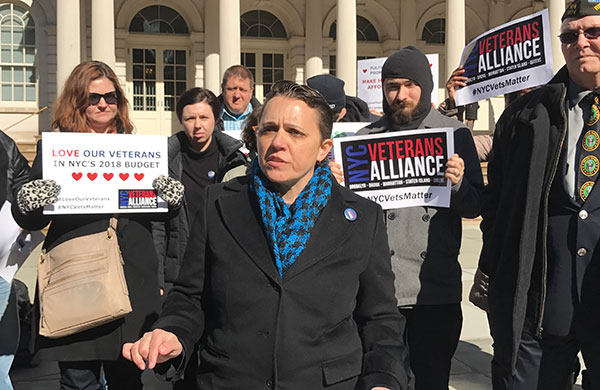
Kristen Rouse, the author
Many New Yorkers may be taking in the change in leadership at the U.S. Department of Veterans Affairs as perhaps just another chapter in a uniquely tumultuous administration. For New York City’s more than 220,000 veterans, however, far more is at stake than just the latest presidential intrigue.
As hearings begin for Rear Admiral Ronny Jackson—an accomplished Naval officer who has served as personal physician to George W. Bush, Barack Obama, and Donald Trump—New Yorkers should be listening in for issues directly affecting our city and region.
Dr. David Shulkin was open and accessible to veteran leaders during his tenure as VA Secretary, which was an important factor for the many VSOs who continued to back Shulkin despite his ethical violations. Both a physician and reformer, Shulkin presided over important bipartisan reforms and was held in high regard as a leader who could get things done for a bureaucracy with a budget of nearly $200 billion and employing more than 370,000 employees, with facilities in all 50 states, four territories, and the Philippines. Shulkin made frequent appearances in New York City, and listened often to the concerns of veteran leaders.
I spoke with Shulkin last November following our community’s shutdown of a proposal that would’ve ended outpatient surgeries at the Brooklyn VA Medical Center. We raised the alarm, and Brooklyn elected leaders, led by Rep. Dan Donovan, took a stand against the move. I was relieved to have Shulkin tell me personally that he didn’t support scaling back services at New York City VA hospitals.
NYC Veterans Alliance members continue to express concern about what’s happening at our VA medical centers located in Manhattan, Brooklyn, and the Bronx. Although veterans generally express satisfaction with the care they receive at the VA’s New York City hospitals, they remain concerned that existing VA services and programs remain in place and continue to improve. Appointment wait times still need to come down. The VA Choice program is too often a bureaucratic nightmare. Staffing shortages plague the VA locally and nationwide. And the Manhattan VA hospital is still undergoing renovations to recover from the damage that Superstorm Sandy inflicted more than five years ago.
With Shulkin’s removal, the future of the VA, locally and nationally, is called into question.
We don’t know yet if Rear Admiral Jackson would give us the same assurance that Shulkin did to protect New York City hospitals. And it remains unclear whether the administration intends on moving toward privatizing VA healthcare. But it’s not simply VA healthcare at stake in New York City—it’s the processing time for VA disability ratings and appeals; management of pensions, home loans, and educational benefits; and sustained funding for the highly effective programs that have reduced veteran homelessness by 90% since 2011 -- all of which countless veterans and families across the New York City Metro area have earned and must be able to rely on, now and into the future.
Congress needs to do the work of determining whether Rear Admiral Jackson’s distinguished career has adequately prepared him to manage a massive government agency that still must undergo transformation in technology and organizational culture. Our New York City congressional delegation must especially ensure that funding stays in place to continue the delivery and improvement of existing services, programs, and benefits for our city’s veterans well into the future.
***
Kristen L. Rouse is a U.S. Army veteran and founding director of NYC Veterans Alliance. On Twitter @TrueBoots and @NYCVetsAlliance.
***
Have an op-ed idea or submission for Gotham Gazette? Email This email address is being protected from spambots. You need JavaScript enabled to view it.
Revising The People’s Charter with Open Minds
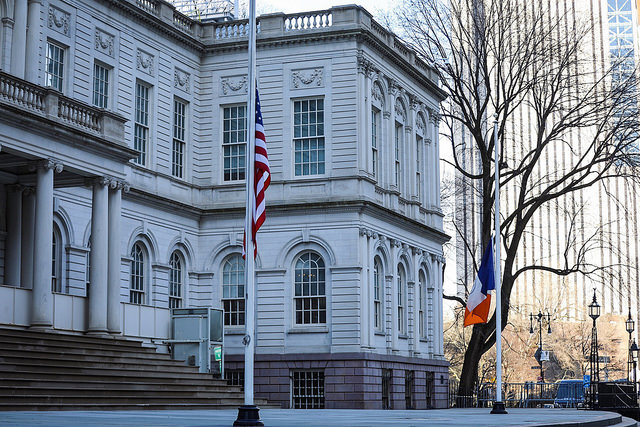
City Hall (photo: Benjamin Kanter/Mayor's Office)
Revision of the City Charter, our central governing document, should not be a one-person show, focused on a single issue. Over the last 25 years, charter revision commissions have been wielded as political tools by mayors to block the building of a West Side Stadium, keep a political rival from potentially ascending to the mayoralty, and stop a referendum that would have limited the size of public school classes. Revisions have largely been narrow and myopic and the end results have been pre-baked according to the mayor’s will.
The last truly transformative commission, convened in 1989, only came about in response to a Supreme Court decision and a series of scandals too big to ignore. But today, that all changes.
We believe this city can do better. A new charter revision commission, which was approved Wednesday by the City Council, can and should be truly democratic and capable of broad systemic reform without predetermined conclusions.
We support campaign finance reform, but also believe that the city’s land use, budget, and planning processes must be overhauled. We want to see the creation of a charter revision commission, but do not believe it should be an extension of one person’s will. That is why we proposed a commission on which no one official would have majority control and that would examine the charter as a whole, without preconditions or marching orders.
We have thought a lot about New York City’s foundational governing document and have numerous specific proposals we would like to see considered. But what we really want is a truly independent commission that will enter the process with open ears and open minds - something that the entire City Council agrees with. Everything should be on the table, nothing should be off limits, and the final product should not be preordained by anyone. We proposed this as elected officials whose very offices have been threatened with elimination in past revisions, so it should be clear we have the courage of our convictions.
Mayor de Blasio’s proposal to lower campaign contribution limits through a revision commission he is calling is a commendable attempt to limit the influence of money in politics. Our commission, which was proposed before the mayor’s, is not a rebuke of his specific policy goals. But our intention is to create a commission that will consider the entire charter and put forth a set of proposals on whatever needs fixing.
It has been nearly 30 years since the City Charter has truly been looked at top-to-bottom with an eye towards real reform. The people of this city deserve an independent commission that will not be directed to take a specific action, but charged with the responsibility to look at the whole picture and bring its recommendations to the people. It should consider whether the Council should have more say over the budget process, whether communities will have more input in land use before deals are all but finalized, whether our current system of checks-and-balances is sufficient to ensure meaningful oversight of mayoral agencies. Those discussions will not be had if the mayor simply appoints a slate of proxies and tells them what to consider and what conclusions to reach.
This does not need to be a zero-sum game, or even a competition. The mayor’s commission can move forward and pursue the ‘democracy agenda’ he envisions. Meanwhile his four appointees can join our commission for an open discussion of what else our charter needs to do to grow and change along with the city. The City Council has already expressed its support and, if the mayor will join us, we can all come together to do what’s best for the people of New York.
***
Gale Brewer is Manhattan Borough President and Letitia James is Public Advocate. On Twitter @GaleABrewer and @TishJames.
***
Have an op-ed idea or submission for Gotham Gazette? Email This email address is being protected from spambots. You need JavaScript enabled to view it.
The Woman to Woman Campaign
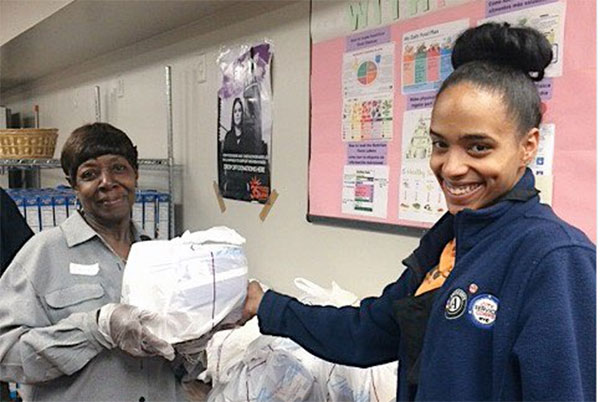
Donating feminine hygiene supplies through Food Bank (photo via @FoodBank4NYC)
The nearly one million women and girls living below the federal poverty level in New York City are often forced to make impossible sacrifices when it comes to their basic needs. Limited budgets mean having to choose between purchasing essentials, like feminine care and household products, and paying for other necessities, like rent and food.
The cost of these feminine care products adds up. On average, women between the ages of 12 and 54 buy approximately 250 feminine care products every year, including pads, tampons, and panty liners. That presents a significant financial burden to families already struggling to balance the competing costs of everyday living expenses and turns basic essentials into luxury products.
Part of the challenge is that low-income families have little support to help defray the cost of non-food essentials, and there is no reliable source of regular donations of sanitary napkins or tampons available to those in need. This means the majority of families struggling to put food on the table have no choice but to pay out of pocket for these necessary items.
This issue is more than a matter of health and hygiene—it’s a matter of dignity. Girls faced with the prospect of attending school without the products they need will opt to skip class, harming their chances at success to avoid embarrassment. Similarly, women in the workplace often encounter these same dilemmas. Our city has made significant recent strides by enacting legislation to ensure women and girls in public schools, shelters, and jails have access to the supplies they need. And the budget just enacted in Albany extends access to public schools throughout the state. But there’s more work to be done.
That’s why Food Bank For New York City launched Woman to Woman, a campaign to make New York the first city to offer feminine care products at all of its food pantries. We are committed to establishing a regular supply of products and creating first-time space on pantry shelves to meet the basic needs of women and girls living in poverty because these New Yorkers face burdens that food alone cannot ease.
This year, we are asking for donations of products and funds to help the women of our city. Right now, thanks to generous support from the City Council, feminine care products are available at 25 of Food Bank’s campus pantries in public schools across the five boroughs but the need is far greater. Almost three in four (73 percent) food pantries and soup kitchens say they need more household and hygiene items to better serve their communities.
This is an opportunity for New Yorkers to take the lead in caring for their most vulnerable neighbors. Needed items include tampons, pads and panty liners, as well as toothpaste, toothbrushes, baby wipes, adult diapers, shampoo, conditioner, and deodorant.
People can continue to donate these products at locations throughout the city. They can also coordinate a product drive at their workplace or rally their friends by hosting an online fundraiser. Additionally, volunteers can sign up to repack donated products at Food Bank’s Bronx warehouse so that they’re ready for distribution to our network of 1,000 charities across the city.
Last, we are calling on New Yorkers to raise their awareness and help remove the stigma and embarrassment around menstrual health. Addressing this problem means having a public conversation about the terrible choices women and girls living in poverty confront every day. No one should be ashamed to need a tampon and the more people talk about it, the better.
By having a greater understanding of the unique challenges women face, especially in an expensive city like New York, we can help overcome them. Ensuring all New Yorkers have full access to the range of essential items they need will help everyone achieve greater dignity, independence, and success.
***
Margarette Purvis is CEO of Food Bank For New York City. On Twitter @FoodBank_Prez & @FoodBank4NYC.
***
Have an op-ed idea or submission for Gotham Gazette? Email This email address is being protected from spambots. You need JavaScript enabled to view it.
The Problem with Cuomo's Payroll Tax
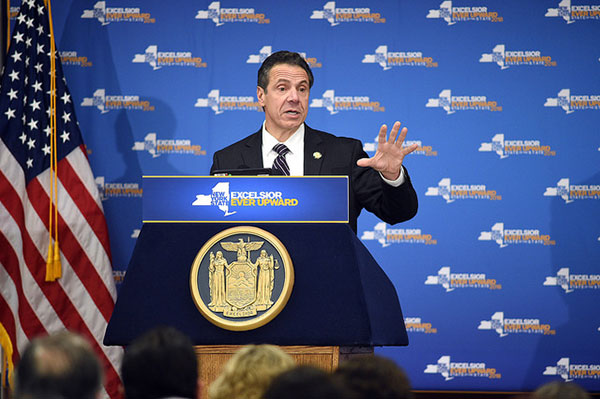
Gov. Cuomo (photo: Kevin P. Coughlin/Governor's Office)
Other high-tax states have considered it, but New York just became the first state to actually do it: revamp its tax code to mitigate the new $10,000 federal cap on deducting state and local taxes (SALT). As part of the new state budget, the Legislature enacted the Governor’s plan for a new voluntary 5% payroll tax New York employers can opt into. It would exempt their employees from paying state income tax, and thereby help keep them below the federal cap.
But the new payroll tax has many detractors, including the New York Business Council, which called many of its provisions unworkable, the New York chapter of the National Federation of Independent Business, which said its members feared it sets the stage for a tax hike on small businesses, and experts convened by the Manhattan Institute, who point out it will penalize commuters from New Jersey and Connecticut. Many predict that only a few small, well-heeled firms will be able to take advantage of it, and many worry the IRS will simply close down the loophole Cuomo just opened.
These objections are all well-founded, but there’s a bigger, more fundamental problem with the scheme: payroll taxes hurt job growth.
In theory, employers who opt into the tax will be made whole because they can pass the cost onto workers by lowering wages 5%. Workers will be made whole since they wouldn’t pay state income tax, and it would help them stay below the federal deductibility limit on SALT. All together, it’s supposed to be a wash.
But in practice it doesn’t work that way. Wages are “sticky” and notoriously hard to pull back once workers attain a certain number on their pay stubs. In a large workforce, getting all employees to accept a nominal 5% pay cut will be a nightmare. Even for small firms with few workers, existing contracts, minimum wage, and competition for sought-after employees will bedevil an across-the-board pay cut. As the New York State Department of Taxation and Finance warned, if employers can't pass the full tax bill onto employees, their net labor costs go up. That drives hiring down.
The new payroll tax doesn't exist in a vacuum, but as part of the larger tax environment, which includes high federal payroll taxes that already inhibit job and economic growth.
They are the biggest taxes a large majority of Americans pay, and the most regressive, squeezing workers who don’t earn enough money to pay income tax or benefit from income tax cuts. Paying payroll taxes lowers workers’ earnings and curtails consumer spending and economic growth. Even so, Congress refused to cut them when it cut federal income and corporate taxes (though Senators Lee and Rubio tried).
Federal payroll taxes also distort relative prices of labor versus. non-labor inputs to business (energy, materials and land) making hiring artificially expensive and consumption artificially cheap. The distortion amounts to over $1 trillion a year (the amount federal payroll taxes raise), or about 5.4% of GDP.
That’s a big, structural drag on jobs that has resulted in a big, structural (though largely hidden) overhang of joblessness. There’s a shocking fact hiding in plain sight in the rosy Bureau of Labor Statistics unemployment charts: out of 257 million non-institutionalized American adults, over 100 million don’t have jobs.
Of those, 95 million aren’t counted as “unemployed;” they’re just considered outside the workforce. That’s legitimate for people who are retired, or who aren’t able or don’t chose to work. But many tens of millions of them, including millions in New York, aren’t working because they lack job opportunity, due in significant part to the corrosive effects of payroll taxation.
To whatever extent firms adopt it, New York's new payroll tax will only compound these problems.
Instead, payroll tax should be cut to boost jobs, both at the federal and state levels, like Colorado did. Since 2008, Colorado’s Job Growth Tax Credit has refunded state payroll tax for job creating businesses. It brought thousands of high-quality jobs to the state and grew its tax base.
Revenue lost from cutting payroll taxes could be replaced with non-labor taxes on resource consumption, waste, inefficiency and pollution. That’s a tax reform approach known as payroll tax shifting. According to the bipartisan group Get America Working!, which I advise, it would reverse payroll tax’s longstanding distortions, roughly doubling the job-creating effects of cutting payroll taxes alone, creating tens of millions of jobs nationwide. In New York, non-labor taxes on consumption we want to limit could raise state revenues and fund tax relief for individuals hurt by the federal deductibility cap.
Which non-labor taxes exactly is a topic for the next budget debate. But there is no lack of options. How about getting serious about collecting the 20% of New York sales tax that still goes unpaid? Or adopting real congestion pricing instead of the quarter-measure in this year’s budget? Or considering the state carbon tax designed by NYRenews that would raise $7 billion annually, help meet New York’s climate goals, and stimulate renewables sector jobs?
New York’s new payroll tax is aimed at downstate, high-paying firms. It might or might not help a narrow band of them at the cost of undercutting job growth. But New York needs a tax policy that boosts employment statewide, including upstate. That’s why we need a tax overhaul that takes the burden off employment and puts it on harmful consumption, waste and pollution.
***
Stephen Kent is president of the public interest PR practice KentCom LLC and consults for the bipartisan employment policy group Get America Working!
***
Have an op-ed idea or submission for Gotham Gazette? Email This email address is being protected from spambots. You need JavaScript enabled to view it.
